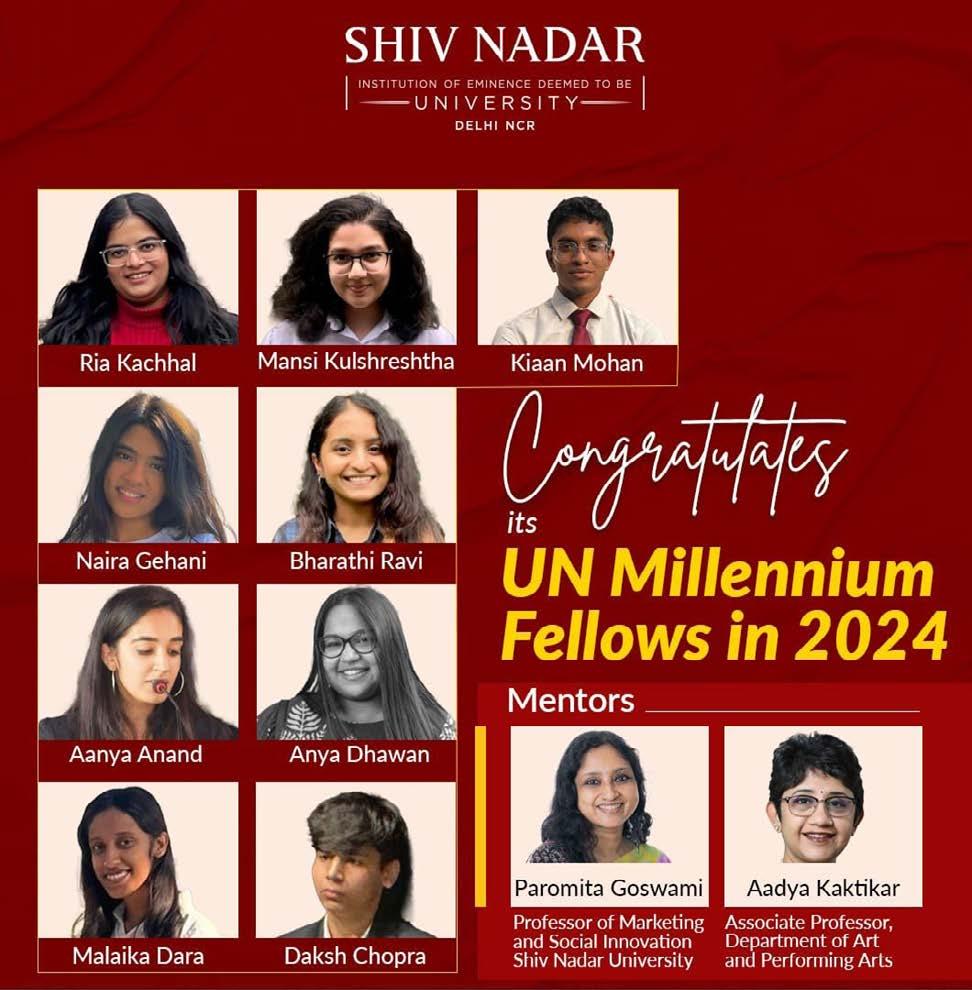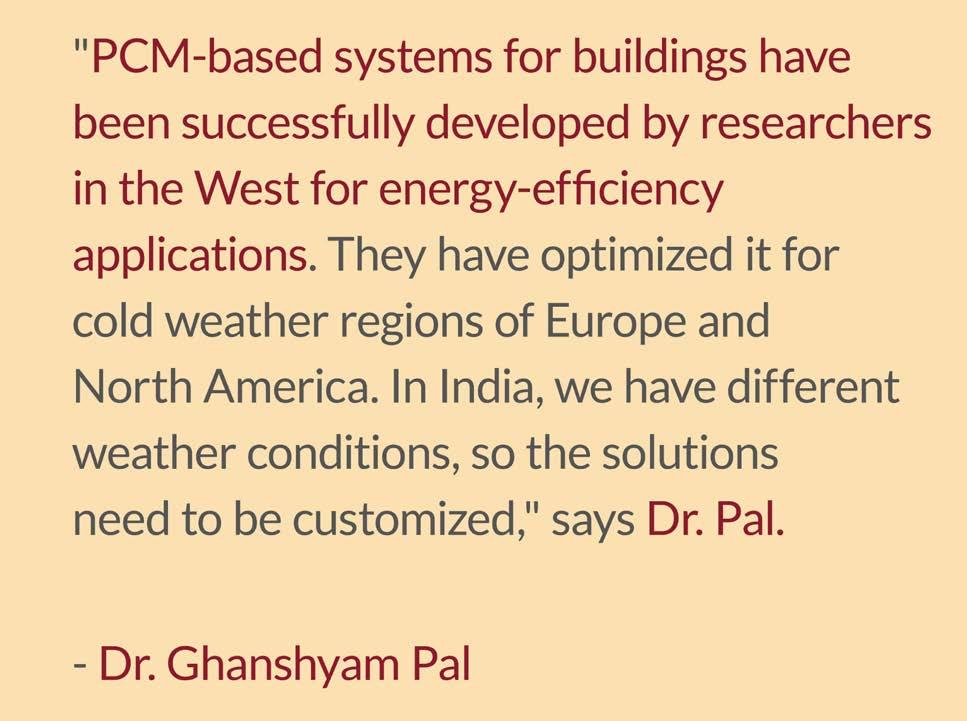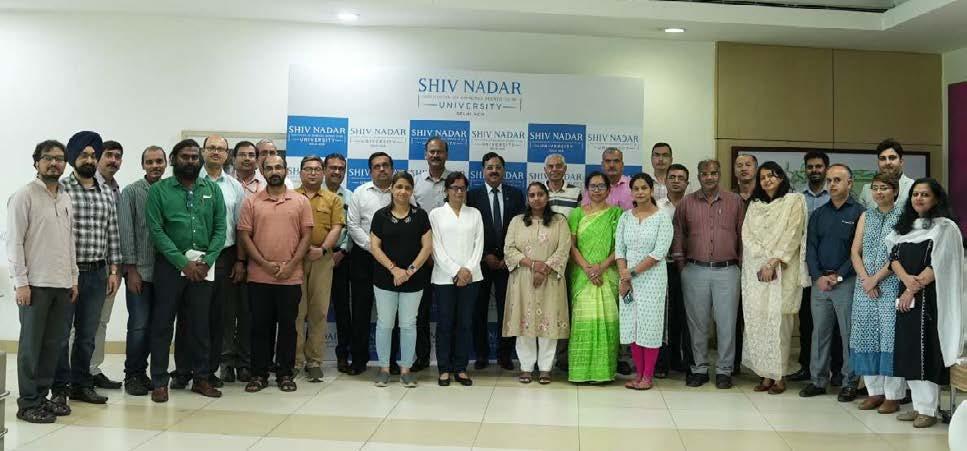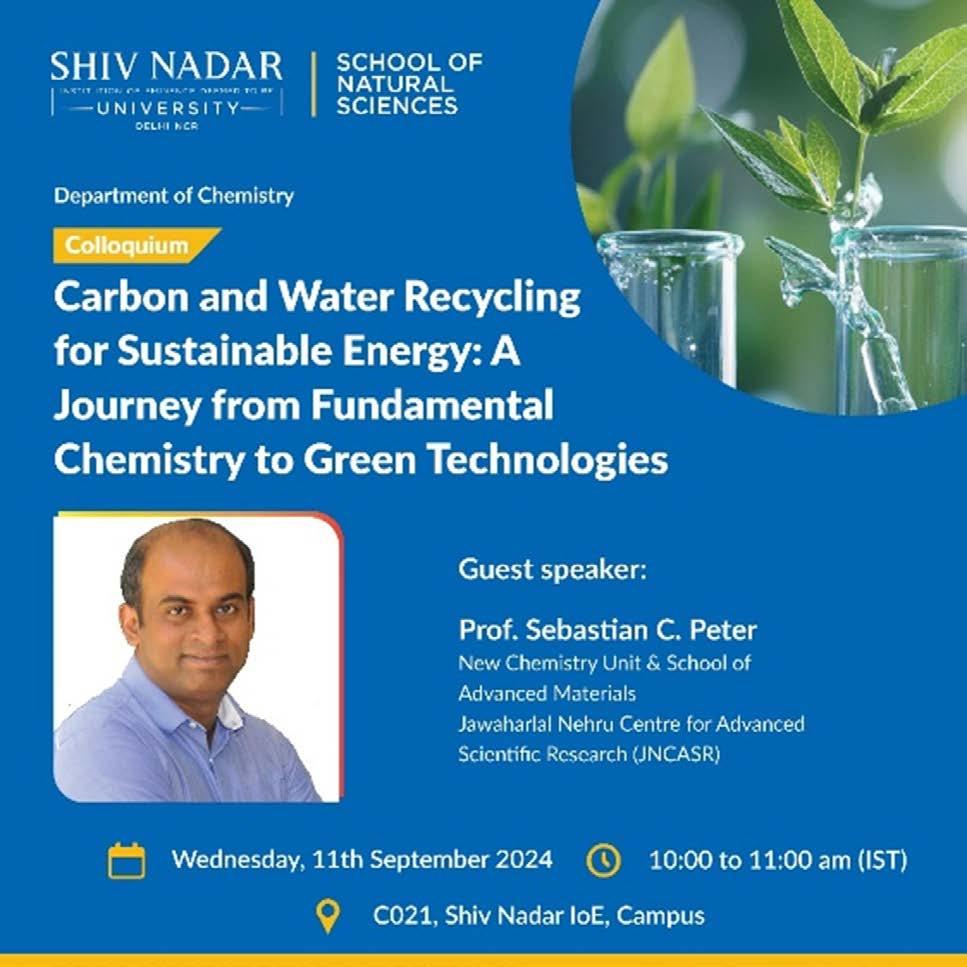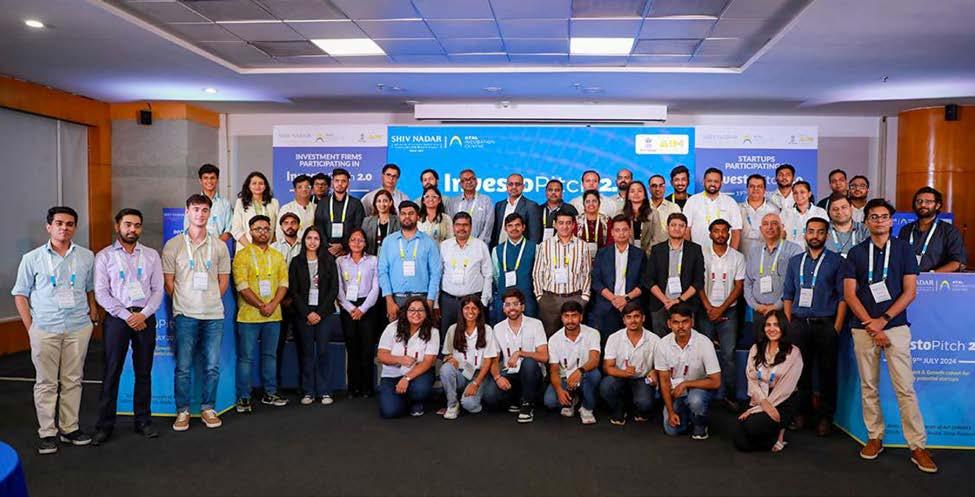Sustainable Development Goal 7 has five targets and seven indicators that address the growing energy demand and an urgent need to mitigate climate change. The underlying focus of the goal is to ensure access to affordable, reliable, sustainable, and modern energy for all.
At Shiv Nadar University, energy is one of the priority research areas. We contribute to SDG 7 through teaching and research related to clean energy, outlining policies on energy use, and promoting energy efficiency in the broader community through partnerships.
To achieve this and more, we take significant steps on campus towards clean energy initiatives, waste management practices, and energy conservation measures that positively impact the local community and work with stakeholders to advance this goal.
TEACHING AND LEARNING
The university offers many courses on new and alternative sources of energy. The Department of Mechanical Engineering offers a course on the Fundamentals of hydrogen fuel cell technology
Almost 92% of the world’s population now has basic access to electricity, and over 666 million people remain without access, indicating that the current rate is insufficient to reach universal access by 20301.
(MED 324). It addresses the need to understand the hydrogen economy and its importance as an alternative energy source. The School of Natural Sciences and the School of Engineering offer courses like non-conventional energy resources (MED 311), Energy conversion technology and energy management (MED 413), Green Chemistry and Sustainability (CHY 554), Solar Energy (MED 403), and Green Energy studies (MED 508). Undergraduate students are offered compulsory courses, such as Energy for Sustainable Future (CCC 614), Use of Energy in Our Daily Life (CCC 624), and Green Energy Technologies (CCC 613).
UN Millennium Fellowship for Shiv Nadar University Students
Our students were selected as UN Millennium Fellows for 2024. This fellowship is presented by the United Nations Academic Impact and MCN and supports undergraduate leadership for the UN Sustainable Development Goals. From 52,000+ applicants from 6,000+ campuses worldwide, 280+ campuses (just 5%) have been selected to host 4,000+ Millennium Fellows in 2024.
1ESMAP, IEA, IRENA, UNSD, World Bank, and WHO. 2025. Tracking SDG 7: The Energy Progress Report 2025. https:// trackingsdg7.esmap.org/.
The students were guided by their Professors, Dr. Paromita Goswami and Dr. Aadya Kaktikar from the School of Management and Entrepreneurship and the School of Humanities and Social Sciences. The award is a testament to the university’s commitment to addressing SDGs while empowering and nurturing global leaders who will direct and shape policies, advance research, and encourage local action to protect the larger global community from future risks.
RESEARCH
Finding new ways to produce maleic anhydride
Dr. Rajesh VM, Associate Professor, Department of Chemical Engineering, offers a potential path for India to be self-reliant in producing maleic anhydride.
Maleic anhydride, a white powder, is the proverbial pivot that propels industries worldwide. The sheer
versatility of this chemical pegs its global market value at a staggering $4.8 billion, projected to cross $7 billion by 2032.
Dr. Rajesh’s research, in collaboration with Bharat Petroleum’s Corporate Research and Development Centre, also stands as an example of the symbiotic relationship between industry and academia.
Shiv Nadar University Pioneers Eco-Friendly Polymers For Carbon Neutrality
Dr. Bimlesh Lochab, Professor, Department of Chemistry, and Dr. Sangeeta Sahu, Post Doctoral scholar at Shiv Nadar University, have developed sustainable polymers from waste sulfur and cardanol, offering a promising solution to plastic pollution and carbon emissions. This is an innovative solution to the global challenge of carbon neutrality. Their research has been published in the ACS Sustainable Chemistry & Engineering journal, introducing a new class of waste-derived polymers, utilizing naturally abundant feedstocks, and achieving attractive features.
Bioenergy Production via Thermochemical Conversion of Waste Biomass
Dr. Sanjeev Yadav, Associate Professor, Department of Chemical Engineering, and his group are working on thermochemical conversion of waste biomass into different forms of bioenergy through an experimental and simulation study.
Improper waste biomass management leads to many environmental concerns, like greenhouse gas emissions, soil degradation, and water


contamination. The research group offers an alternative to waste management by using thermochemical conversion methods to generate energy. This year’s experimental studies involved the conduct of steam gasification and fast pyrolysis of mixed food waste. Steam gasification was conducted in the presence of a novel catalyst, which significantly enhanced hydrogen production. It also helped reduce the tar generation effectively from the steam gasification of mixed food waste. The second experimental work studied the effect of hot vapor residence time (HVRT) on bio-oil production via fast pyrolysis of mixed food waste. It showed that HVRT seriously affected the occurrence and disappearance of the important phase separation phenomenon. Additionally, this study showed that the bio-oil contained a large fraction (80–95 %) of fatty acid alkyl esters (FAAEs), the potential blend for fossil-based diesel. The third study was a modelling and simulation work done using Aspen Plus for groundnut shell gasification using a bubbling fluidized bed gasifier. The developed model agrees in terms of composition, yield, and higher heating value of the syngas generated experimentally.
Rice husk-derived self-healing superhydrophobic films using a solvent-less approach for drag reduction and oil absorption behaviour.
This work focuses on a sustainable approach to transforming rice-husk waste into self-healing superhydrophobic films with potential application for drag-reduction and oil absorption. Rice husk was transformed into amorphous nano silica particles (d50 ∼ 150 nm) exhibiting mesoporosity with a
surface area of 400 m2/g. Superhydrophobic films fabricated using a solvent-less approach showed the transition from flattened to nano-globular morphology with increasing silica content in polydimethylsiloxane (PDMS), leading to exceptional superhydrophobicity. The optimized film with a particle fraction of 60 % exhibited high de-wetting (> 150º) and mechanical strength (∼7 MPa). The film showed extremely low water droplet adhesion of ∼19 μN, similar to that of a lotus leaf, owing to high negative Laplace pressure. Significantly, the film exhibited persisting de-wettability and endurance under harsh chemical, thermal, and mechanical conditions. The robustness is further fortified with room temperature self-healing and real-time self-regeneration characteristics, persisting even after strong acids and significant abrasion exposure. The multidimensional aspects of the film began with a 70 % drag reduction and effective oil-water separation. The present work provides a sustainable pathway for managing agricultural waste and a practical and easy-to-implement approach to tackling oil spill incidents.
Pathak, Prateek, Prabhjot Kaur, and H. S. Grewal. “Rice husk-derived self-healing superhydrophobic films using solvent-less approach for drag reduction and oil absorption behaviour.” Industrial Crops and Products 222 (2024): 119812.
Research at the Soft Matter Lab at Shiv Nadar University
Dr. Ashish Thokchom, Assistant Professor, Department of Chemical Engineering, works on sustainable applications of structural colors. Leading
research in the Soft Matter lab, Dr. Thokchom is looking to develop flexible and tunable photonic crystal devices for applications like anti-counterfeit, gas sensors, and camouflage. Closely aligned with SDG 7, his work ensures access to affordable, reliable, sustainable, and modern energy. And innovations such as energy-efficient building films that reflect harmful sun rays.
Developing sustainable building solutions for the economically weaker section (EWS)
Dr. Ghanshyam Pal, Associate Professor in the School of Engineering, is researching phase change materials to ensure buildings remain relatively cooler during summer and warm during winter. He has developed a nano-enhanced phase change material system using organic materials, biopolymers, and industrial by-products.
Dr. Pal’s research is directly connected to SDG 7 (Clean Energy), SDG 11 (Sustainable Cities and Communities), and SDG 9 (Innovation and Infrastructure). Working at the Advanced Materials and Building Energy (AMBE) Lab at Shiv Nadar University, Dr. Pal says his passion for developing sustainable building solutions for the economically
weaker section (EWS) housing has been the fundamental driving force behind his research work. Recently, Dr. Pal was honoured with the prestigious Concrete Technologist of the Year (Academics) 2024 by the Concrete Engineers Association, India, for his outstanding contributions through research on cementitious materials, including concrete, and his commitment to developing innovative solutions for alternative sustainable construction materials.
Conversations on Campus
International Conference on Sustainable Nanomaterials Integration & Organization for Energy and Environment (iSNIOE2-2024)
Shiv Nadar University, in partnership with the University of New South Wales, Sydney, Australia, and KTH Royal Institute of Technology, Sweden, organized the International Conference on Sustainable Nanomaterials Integration & Organization for Energy and Environment (iSNIOE2-2024). With over 250 participants from India and abroad, this four-day conference united researchers and practitioners from academia, industry, and research laboratories worldwide, facilitating the dissemination of knowledge in sustainable nanomaterials and their innovative applications in renewable energy and environmental conservation.
The conference showcased 183 presentations, comprising 11 Plenary Speakers, 20 keynote speakers, 47 invited speakers, 46 oral presentations, 59 poster presentations, and over 60 speakers and researchers from various parts of the world.
MAGSOS Conference on Modern Aspects of Green and Sustainable Organic Synthesis
The Department of Chemistry, School of Natural Sciences, Shiv Nadar University, in collaboration with HEIA-FR, Chemistry Department, Switzerland, organized MAGSOS, a conference on Modern Aspects of Green and Sustainable Organic Synthesis, at the Shiv Nadar University campus on November 26 - 29, 2024.
Discussion to explore research partnerships between the University and India’s biggest commercial oil corporation
Shiv Nadar University Delhi NCR on Wednesday hosted Mr. ALOK SHARMA, Director, Research and Development Centre, Indian Oil Corporation Limited, (IOCL) along with his leadership team.
Discussing ways to explore research partnerships between the university and India’s biggest commercial oil corporation in nanotechnology, renewable energy, sustainable energy technologies, energy storage and conversion, and materials processing, Mr. Sharma highlighted, Despite being a young institution, the research done by Shiv Nadar University is commendable. There are many opportunities for collaboration in research and industry-oriented projects that can drive innovation, boost economic growth, and contribute to societal progress. Such collaborations can help convert research into marketable products and services with the support of the industry.
CAMPUS OPERATIONS
At Shiv Nadar University, we are committed to contributing to the overall socio-environmental sustainability. We have taken multiple initiatives in the structured sustainability framework with specific targets and timelines, advancing several Sustainable Development Goals.
Green Building Design and Operations
All buildings on campus comply with the National Building Code, certified by the Indian Green Building Council (IGBC) or Leadership in Energy and Environmental Design (LEED). Several buildings are LEED Gold certified and incorporate green building principles such as natural lighting, efficient insulation, sustainable materials, and low-flow plumbing fixtures, thus making them water and energy-efficient. Besides achieving EHS certification, the university has a policy that promotes environment-friendly and low-emission practices in water, energy, waste, habitat protection, etc. We have also been awarded ISO 14001:2015 and ISO 45001:2018 accreditation without any nonconformance or observation.
Renewable Energy on Campus
We have undertaken an initiative to transition to clean energy sources on campus. As part of this, a 1.6 MW solar power plant is installed and commissioned on campus that takes care of as much as 26 percent of the needs of the campus. The goal is to go to 30 percent and beyond.
Renewable Energy Generation
– 270 % rise between 2019-20 and 2023-24
Enhance Energy Efficiency
We have a system for continually reviewing campus energy use and identifying opportunities for improvement to update our energy consumption analysis and conservation plan. This helps in energy optimization through energy-efficient practices on campus. Many energy-efficient appliances have been incorporated, such as:
• Energy Optimization Monitors in our LEED and IGBC- Gold certified building with integrated
sensors, IoT devices, and automation systems for optimized energy use and reduced overall environmental impact
• Effective electric vehicle infrastructure on campus to transition 50% of the car fleet to electric vehicles, increase mobility on campus, and reduce carbon footprint and dependency on fossil fuels.
• Modular sewage treatment plant technology is installed on campus and has a capacity of 734 KLD. The STP currently treats 550 KLD of water from the entire campus, including campus housing.
• Monitoring platforms installed to track energy usage, waste generation, water consumption, and other sustainability metrics to enable informed decisions for continuous improvement
• 1.6 MW solar panels installed on campus across academic and residential blocks to transition from complete captive power and generate clean, sustainable energy on campus
• Energy-saving policy embraced, replacing 11 KV grid power with a 33 KV grid power supply and removing the need to run standby power through diesel generators.
As a part of our Energy Consumption Analysis and Conservation Plan, we review our energy use continually to identify opportunities for improvement. To document the energy consumption of each building, electricity meters are installed in every building, and a complete analysis of energy consumption is reported every month in the “Energy Performance Index Report.” This helps to check waste continuously.
Green House Gas Emissions: 13.94% reduction between 2023-24 and 2022-23
Alternative Mode of transport to achieve sustainable transportation
We are a residential campus for all students and many faculty members. For those who stay outside the campus, a well-planned transport system is in place, and employees are encouraged to be sensitive to their use and optimize their air and road travel. For weekly needs, planned shuttles are provided. To transition to clean power and reduce dependence on fossil fuels, we plan to transition 50% of the car fleet to electric vehicles. The university currently has
60% CNG, 30% petrol, and 10% diesel cars. The plan is that any new inventory added to this would be an electric vehicle.
On campus, we use sustainable transportation options such as walking, biking, carpooling, and public transit. We have a fleet of E-buses and Golf carts with over 150 seating capacity. This, in turn, has helped increase mobility on a large campus like ours and is also a step towards reducing the carbon footprint and dependency on fossil fuels.
PARTNERSHIPS
Partnership with Industry
Dr. Sanjeev Yadav, Associate Professor, Department of Chemical Engineering, and his research group work with Varhad Capitals Pvt Ltd, a Nagpurbased industry. The industry is supporting work on biomass conversion into bioenergy and has signed a Memorandum of Understanding for three years. Varhad is leading the initiatives in carbon dioxide removal (CDR) and soil enhancement. They cultivated a vast network of farmers through 165 farmer cooperatives in India. Using carbon-rich materials like cotton and pigeon pea stalks, they achieved a Carbon Dioxide Removal rate of 2.4 tons of carbon dioxide per ton of biochar.
The group has also designed a portable pyrolyzer capable of using various kinds of waste biomass, especially agri-residues, to produce biochar. This has already yielded large biochar production across many states with the help of the industry partner. Biochar production is a sustainable and environmentally responsible process that manages agricultural waste efficiently.
Industry-Academia partnership to drive sustainable technological advancements
Shiv Nadar University, in partnership with Bharat Petroleum’s Corporate Research & Development Centre (CRDC), is a significant stride towards advancing sustainable chemical processing technologies. By focusing on process intensification for highly exothermic reactions, the project aims to develop novel reactor designs that enhance energy efficiency and reduce waste. This initiative aligns with several critical sustainable development goals.
At the same time, this partnership exemplifies how industry-academia collaborations can drive sustainable technological advancements, aligning with India’s commitment to the United Nations Sustainable Development Goals (SDGs).
InvestoPitch 2.0 - a unique investment platform
Atal Incubation Center at the Shiv Nadar University organized InvestoPitch 2.0, a platform to foster innovation and entrepreneurship for startups to raise funds, generate leads, and enable deal closures. The event saw active participation of startups from diverse sectors, including biotechnology, industry 4.0, AI/ML, AR/VR, renewable energy, health tech, circular economy, and green energy.
The event’s success was in excellent participation, elevator pitches, networking opportunities, and investor speed mentor dating, where investors shared their advice and insights with the startups.
Department of Physics hosted
a
four-day international conference on Sustainable Nanomaterials Integration & Organisation for Energy & Environment
The Department of Physics at Shiv Nadar University, in partnership with UNSW Sydney, Australia, and KTH-Sweden, organized the International Conference on Sustainable Nanomaterials Integration & Organization for Energy and Environment (iSNIOE2-2024).
With over 250 participants from India and abroad, this conference brought together researchers and practitioners from academia, industry, and research laboratories worldwide, facilitating the dissemination of groundbreaking knowledge in sustainable nanomaterials and their innovative applications in renewable energy and environmental conservation. During the four-day event, the conference featured parallel symposia dedicated to both experimental and theoretical research on sustainable nanomaterials, nanoscience, and miniaturized, as well as flexible devices for energy and environmental applications. The conference showcased 183 presentations, comprising 11 Plenary Speakers, 20 keynote speakers, 47 invited speakers, 46 oral presentations, and 59 poster presentations, providing valuable insights and fostering collaborations among participants.

Shiv Nadar Institution of Eminence is fully committed to the UN Sustainable Development Goals (SDGs). We have embraced a four-pronged strategy for SDGs through teaching, research, our core institutional practices, and partnerships.
Deepa Hazrati Senior Manager, Office of the Vice-Chancellor deepa.hazrati@snu.edu.in
Shiv Nadar Institution of Eminence Gautam Buddha Nagar, Uttar Pradesh, India



